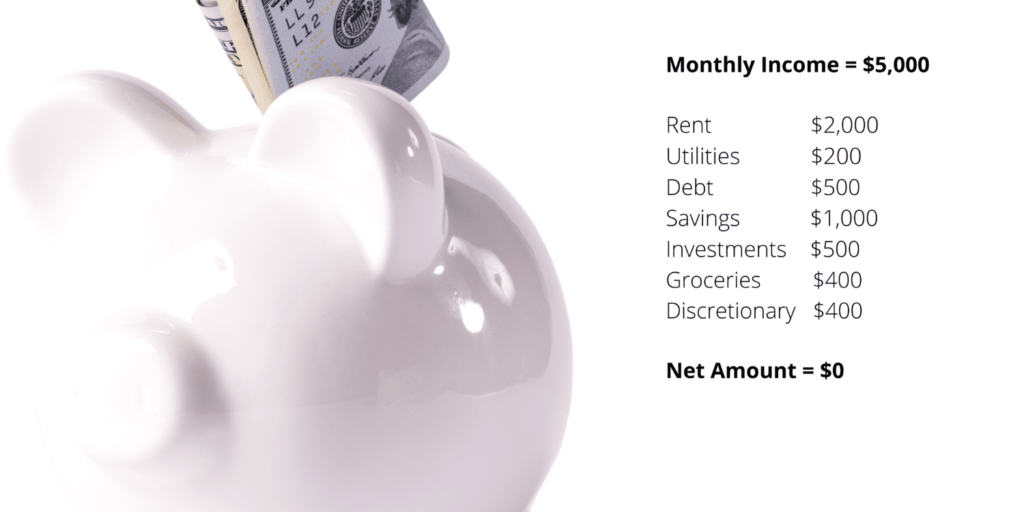6 Steps To Create A Zero-Based Budget
In the finance world, we often talk about the need for a budget and how it’s the foundation of any financial plan. However, financial professionals do not always do a good job providing the practical advice of simply how to create a budget.
In fact, we go into great detail in our Financial Foundations Course about how to create a budget that works for you. For purposes of this post, we will focus on some high level tips when it comes to creating a budget.
There are different methods you can use to go about creating a monthly budget, but the one we will focus on is the zero-based budgeting approach. Simply put, this method accounts for all of your income and expenses, where the net result is zero. For example, even your designated savings are accounted for in this method as “expenses”, although you are technically setting aside the money and not spending it.
This method allows you to designate a place for each dollar of expected income to go every month. In the zero-based method, if you earn $5,000 per month after taxes, every dollar of that income is accounted for in the budget, whether it’s spent, saved, or donated.

Step 1 – Decide What Format to Build Your Budget In
Decide what format you want to build your budget in. For example, some people are very comfortable with excel or software, while others may be just as effective in following a budget written out in a notebook with pen and paper. If you are creating a budget for the first time, writing it out on a piece of paper may be the easiest way to get started before eventually moving on to an app-based software approach.
For our clients, we use the budgeting feature in RightCapital which allows you to easily link all of your financial accounts and create monthly categories for spending, saving, and giving.
Step 2 – Start With Your Expected Monthly Income
Record or write down your planned income for the month. Start with your most predictable source of income first and move on to any passive income earned from investments/properties and any side hustle income.
The income listed in each line item should be net of taxes, so your actual take home pay or what hits your bank account each month. If your income is typically more variable, try to average out what your expected monthly income will look like.
Step 3 – List Out Your Fixed/Essential Monthly Expenses
List out your fixed monthly expenses, starting with the most important and essential ones first.
For example, rent or mortgage payments (shelter) would likely be listed first , followed by other vital expenses like utilities/cell phone bill, insurance premiums (risk management), child care expenses, your estimated grocery bill and minimum debt payments (if applicable).
It’s important to make sure your most basic necessities are accounted for first and foremost in your monthly budget before moving on to variable expenses.
Step 4 – Designate How Much You Plan To Save Each Month
At this point, map out how much you plan on saving each month. Do you have a fully funded emergency fund in place (3 to 6 months of expenses)? If not, how much can you contribute according to your monthly budget to move the needle towards a fully funded emergency fund.
What other types of savings can you contribute to? For example, are you saving for a down payment on a house or are you trying to set aside some money for your child’s college education every month?
Pay yourself first before moving on to discretionary expenses!
Step 5 – List Out Your Variable/Discretionary Spending
This is where you begin to map out your variable expenses, also known as discretionary spending. This may be items like monthly subscriptions to streaming services, eating out at restaurants and bars, and other entertainment/fun money.
This is an important part of your overall budget because we still need to set aside money to spend on things we enjoy. Building this into your budget also gives you the psychological freedom to be able to spend on these discretionary items without feeling guilty or wasteful.
Step 6 – Net Your Income and Expenses to Zero
At this point, you want to total all of your income and all of your planned expenses, including what you may have included in that savings bucket. Ideally, your net number should be zero, meaning you have accounted for and designated every dollar of income.
If not, where can you or should you reallocate any extra income not captured. For example, could you put an extra payment towards any outstanding high interest debt each month or maybe you can allocate more towards a vacation fund?
Think of your budget as a set of guidelines to help you be aware of what your money is doing every month rather than a rigid set of rules you must follow. Your budget should be a customized training plan, not a crash diet!
Summary
A zero-based budget can be tricky for those with more variable income, like people who are freelancers and self-employed. This type of variable income can make it difficult to stick to a consistent budget every month. However, it’s a relatively simple approach to budgeting and it ensures you are “paying yourself first” by designating a savings category for your hard-earned cash.
Keep in mind, your budget should not be seen as restrictive or some type of mental handcuffs, but rather as a tool to promote your financial independence and psychological freedom. This is exactly what building an awareness of your income and spending each month allows you to do.
Rather than taking a reactive approach every month when you look at your bank statements, having an effective and realistic budget in place ensures that you are in control of making your money work for you.
Before you take on any investment or retirement strategy, it is vital that you seek out proper investment and tax advice beforehand. Investment performance is never guaranteed and investments may lose some or all of their value. On top of that, there may be severe tax consequences if withdrawals are taken improperly and can have a significant impact on your portfolio and retirement. Although we provide Investment Advice and Personal Financial Planning Services, we at MWM do not provide tax advice and any tax advice should be rendered by a licensed tax professional such as a CPA.
Securing Your Future With Premier Financial Solutions
The world of finances is riddled with complexities. From student loan repayments and debt management to asset allocation and retirement planning, millennials face much uncertainty when it comes to managing their wealth. Therefore, we at Millennial Wealth Management strive to provide a new approach to financial advice that not only enhances your level of financial literacy but also presents curated solutions that are tailored to help you achieve your life goals. Our team is equipped with the tools and expertise to analyze your current financial situation while also setting you up for future success. Visit our website or call a member of our team today and make the first step to taking control of your finances with confidence.

